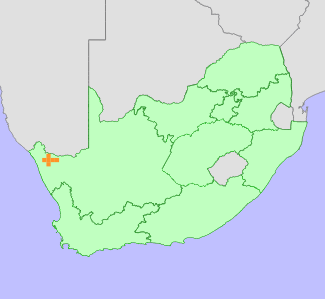|
Scientific Name | Conophytum flavum N.E.Br. subsp. novicium (N.E.Br.) S.A.Hammer |
Higher Classification | Dicotyledons |
Family | AIZOACEAE |
Synonyms | Conophytum ellipticum Tischer, Conophytum luteolum L.Bolus, Conophytum luteolum L.Bolus var. luteolum, Conophytum luteolum L.Bolus var. macrostigma L.Bolus, Conophytum novicium N.E.Br., Conophytum rubristylosum Tischer |
National Status |
Status and Criteria | Endangered A4d |
Assessment Date | 2021/11/26 |
Assessor(s) | A.J. Young, P.G. Desmet, I. Ebrahim, D. Guo, A. Harrower, L. Jabar, L. Knoetze, C. Rodgerson, P.C.V. Van Wyk & N.N. Mhlongo |
Justification | This succulent is endemic to the Northern Cape province of South Africa with an extent of occurrence (EOO) of 1,850 km² and area of occupancy (AOO) of 204 km². The population is in decline due to illegal collection for the ornamental succulent plant trade. Illegal collection is likely to increase as there has been a dramatic increase in the number of species and volume of plants targeted since 2019. The continued threat of illegal collection is therefore regarded as high for this particular taxon and a decline of 30-40% of the population is possible within the next three generations (90 years) due to this activity. Climate change is also impacting the population with a loss of 36% predicted by 2080. It therefore qualifies as Vulnerable under criterion A4. |
Distribution |
Endemism | South African endemic |
Provincial distribution | Northern Cape |
Range | This succulent is endemic to the Northern Cape province of South Africa. |
Habitat and Ecology |
Major system | Terrestrial |
Major habitats | Desert, Nama Karoo, Succulent Karoo |
Description | This succulent is widespread and primarily found in the Succulent Karoo biome but also the Nama-Karoo and Desert biomes. It occurs in the Richtersveld, Namaqualand Hardeveld and Bushmanland & West Griqualand bioregions. Plants are associated with quartz patches and boulders. This taxon has a generation length of 30 years. It is expected to be sensitive to the impacts of climate change as it does not disperse and while adapted to arid conditions, is dependent on limited seasonal rainfall. Species in the genus are sensitive to long periods of drought. Drought related mortality has been observed for other closely related taxa within the genus. |
Threats |
| This taxon is currently threatened by illegal collection for the international trade in ornamental succulents since 2019. As a result the population is experiencing initial levels of decline. This is likely to increase in future as there has been a dramatic increase in the number of species and volume of plants targeted since 2019.
Anthropogenic climate change is a long-term threat to this succulent. Loss of vegetation cover has been observed across the geographic range occupied by this plant via Landsat imagery between 1984 and 2018 indicating a decline in habitat quality. Climate models for the likely emission scenarios where emissions stay at present day levels (RCP 2.6) (Hausfather and Peters 2020) and worst case scenarios where emissions continue to increase during the 21st century (RCP 8.5) indicate that there will be a loss of suitable bioclimatic envelope of between 56% and 95% by 2080 for this taxon. Species in this genus have limited dispersal ability and migration to suitable habitats elsewhere is regarded as highly unlikely. However, as this taxon occurs across several vegetation units it is expected to have a level of resilience to climate change and the expected population loss is reduced by 20% to 36%. |
Population |
No formal estimate of population size has been made for this relatively widespread and variable succulent but is likely to be between 250,000 and 500,000 mature individuals. The population is in decline due to illegal collection for the ornamental succulent plant trade.
|
Population trend | Decreasing |
Assessment History |
Taxon assessed |
Status and Criteria |
Citation/Red List version | | Conophytum flavum N.E.Br. subsp. novicium (N.E.Br.) S.A.Hammer | Least Concern | Raimondo et al. (2009) | |
Bibliography |
Hammer, S. 2002. Dumpling and his wife: New view of the genus Conophytum. EAE Creative Colour, Norwich.
Hammer, S.A. 1993. The genus Conophytum: A conograph. Succulent Plant Publications, Pretoria.
Hausfather, Z. and Peters, G.P. 2020. Emissions - the 'business as usual' story is misleading. Nature 577(618-620).
Opel, M.R. 2004. The rediscovery of Crassula alcicornis. Haseltonia 10:38-40.
|
Citation |
| Young, A.J., Desmet, P.G., Ebrahim, I., Guo, D., Harrower, A., Jabar, L., Knoetze, L., Rodgerson, C., Van Wyk, P.C.V. & Mhlongo, N.N. 2021. Conophytum flavum N.E.Br. subsp. novicium (N.E.Br.) S.A.Hammer. National Assessment: Red List of South African Plants version 2024.1. Accessed on 2025/12/02 |
 Comment on this assessment
Comment on this assessment


